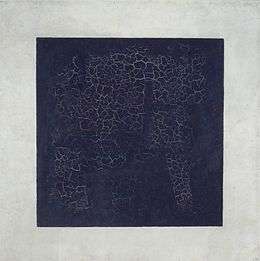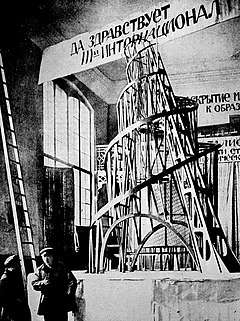Russian avant-garde
The Russian avant-garde was a large, influential wave of avant-garde modern art that flourished in the Russian Empire and the Soviet Union, approximately from 1890 to 1930—although some have placed its beginning as early as 1850 and its end as late as 1960. The term covers many separate, but inextricably related, art movements that flourished at the time; including Suprematism, Constructivism, Russian Futurism, Cubo-Futurism, Zaum and Neo-primitivism.[2][3][4][5] Many of the artists who were born, grew up or were active in what is now Belarus and Ukraine (including Kazimir Malevich, Aleksandra Ekster, Vladimir Tatlin, Wassily Kandinsky, David Burliuk, Alexander Archipenko), are also classified in the Ukrainian avant-garde.[6]
_by_Wassily_Kandinsky.jpg)
.jpg)
.jpg)




.jpg)
The Russian avant-garde reached its creative and popular height in the period between the Russian Revolution of 1917 and 1932, at which point the ideas of the avant-garde clashed with the newly emerged state-sponsored direction of Socialist Realism.[7]
Artists and designers
Notable figures from this era include:
- Alexander Archipenko
- Vladimir Baranoff-Rossine
- Alexander Bogomazov
- David Burliuk
- Vladimir Burliuk
- Marc Chagall
- Ilya Chashnik
- Aleksandra Ekster
- Robert Falk
- Moisey Feigin
- Pavel Filonov
- Artur Fonvizin
- Naum Gabo
- Nina Genke-Meller
- Natalia Goncharova
- Elena Guro
- Vasily Kandinsky
- Lazar Khidekel
- Ivan Kliun
- Gustav Klutsis
- Pyotr Konchalovsky
- Eugène Konopatzky
- Sergei Arksentevich Kolyada
- Alexander Kuprin
- Mikhail Larionov
- Aristarkh Lentulov
- El Lissitzky
- Kazimir Malevich
- Paul Mansouroff
- Ilya Mashkov
- Mikhail Matyushin
- Vadim Meller
- Adolf Milman
- Solomon Nikritin
- Alexander Osmerkin
- Liubov Popova
- Ivan Puni
- Kliment Red'ko
- Alexei Remizov
- Alexander Rodchenko
- Olga Rozanova
- Léopold Survage
- Varvara Stepanova
- Georgii and Vladimir Stenberg
- Vladimir Tatlin
- Nadezhda Udaltsova
- Vasiliy Yermilov
- Ilya Zdanevich
- Alexandr Zhdanov
Journals
Filmmakers
Writers
- Isaac Babel
- Andrei Bely
- Elena Guro
- Velimir Khlebnikov
- Daniil Kharms
- Aleksei Kruchenykh
- Vladimir Mayakovsky
- Viktor Shklovsky
- Sergei Tretyakov
- Marina Tsvetaeva
- Sergei Yesenin
- Ilya Zdanevich
One of the few writers for example, like the novelist, short story writer and essayist, Yevgeny Zamyatin (1884-1937), did not fully devote his writing career into experimenting with Russian avant-garde art, while instead he decided of advocating and praising for the avant-garde movement, as a resistance to the becoming censorship of independent literary ideas in published and purchasable books in the U.S.S.R.[8] He gave form for his ideas by writing books and pamphlets about the negatives of the singular ideology which was the state sponsored "Social Realism" and his opposition towards it. One of his quotes, "In art the surest way to destroy, is to canonize one given form and one philosophy," (Essay - The New Russian Prose.)[9] is one proof of his anti-totalitarian stance which is present throughout his whole literary career, most popularly in his novel "We" and his essay works. He particularly wrote about how can there be a beneficially progressive and developmental relationship between societies and the free expression of art, "But harmful literature is more useful than useful literature, for it is anti-entropic, it is a means of combating calcification, sclerosis, crust, moss, calmness" (Essay - Literature, Revolution, Entropy).[10] Yevgeny Zamyatin's "We" and it's ideological support for freedom for oneself and government, would influence writers in Western Europe and the U.S.A. (e.g. George Orwell's "1984," Kurt Vonnegut's "Player Piano," etc.)[11]
Theatre directors
Architects
- Yakov Chernikhov
- Moisei Ginzburg
- Ilya Golosov
- Ivan Leonidov
- Konstantin Melnikov
- Vladimir Shukhov
- Alexander Vesnin
Preserving Russian avant-garde architecture has become a real concern for historians, politicians and architects. In 2007, MoMA in New York City, devoted an exhibition to Soviet avant-garde architecture in the postrevolutionary period, featuring photographs by Richard Pare.[12]
Composers
- Samuil Feinberg
- Arthur Lourié
- Mikhail Matyushin
- Nikolai Medtner
- Alexander Mossolov
- Nikolai Myaskovsky
- Nikolay Borisovich Obukhov
- Gavriil Popov
- Sergei Prokofiev
- Nikolai Roslavets
- Leonid Sabaneyev
- Alexander Scriabin
- Vissarion Shebalin
- Dmitri Shostakovich
Many Russian composers that were interested in avant-garde music became members of the Association for Contemporary Music which was headed by Roslavets.
See also
References
- Wassily Kandinsky, Untitled (study for Composition VII, Première abstraction), watercolor, 1913, MNAM, Centre Pompidou
- Hatherley, Owen (2011-11-04). "The constructivists and the Russian revolution in art and achitecture". The Guardian. ISSN 0261-3077. Retrieved 2019-12-13.
- "Cubo-Futurism | art movement". Encyclopedia Britannica. Retrieved 2019-12-13.
- Douglas, Charlotte (1975). "The New Russian Art and Italian Futurism". Art Journal. 34 (3): 229. doi:10.2307/775994. ISSN 0004-3249.
- "A Revolutionary Impulse: The Rise of the Russian Avant-Garde". The Museum of Modern Art. Retrieved 2019-12-13.
- "Welcome to Ukrainian Avant-garde!". avantgarde.org.ua (in Ukrainian). Retrieved 2019-12-13.
- Groys, Boris (2019-12-31), "3. The Birth of Socialist Realism from the Spirit of the Russian Avant-Garde", The Russian Avant-Garde and Radical Modernism, Academic Studies Press, pp. 250–276, ISBN 978-1-61811-142-5, retrieved 2019-12-13
- Yevgeny Zamyatin's essay - Tomorrow (last paragraph - translated by Mirra Ginsburg.)
- Yevgeny Zamyatin's essay - "The New Russian Prose" (pg. 124, third paragraph, line 26-27 - translated by Mirra Ginsburg.)
- Yevgeny Zamyatin's essay - "On Literature, Revolution, Entropy and Other Matters" (pg. 109, paragraph 2, translated by Mirra Ginsburg and corrected to be closer to the original text by a Russian native speaker)
- Yevgeny Zamyatin - Wikipedia - Sub-chapter, Legacy
- "Lost Vanguard: Soviet Modernist Architecture, 1922–32". MoMA. 2007. Retrieved 1 August 2019.
- Further Reading
- Friedman, Julia. Beyond Symbolism and Surrealism: Alexei Remizov's Synthetic Art, Northwestern University Press, 2010. ISBN 0-8101-2617-6 (Trade Cloth)
- Nakov, Andrei. Avant Garde Russe. England: Art Data. 1986.
- Kovalenko, G.F. (ed.) The Russian Avant-Garde of 1910-1920 and Issues of Expressionism. Moscow: Nauka, 2003.
- Rowell, M. and Zander Rudenstine A. Art of the Avant-Garde in Russia: Selctions [sic?] from the George Costakis Collection. New York: The Soloman R. Guggenheim Museum, 1981.
- Shishanov V.A. Vitebsk Museum of Modern Art: a history of creation and a collection. 1918–1941. - Minsk: Medisont, 2007. - 144 p.
- “Encyclopedia of Russian Avangard. Fine Art. Architecture Vol.1 A-K, Vol.2 L-Z Biography”; Rakitin V.I., Sarab’yanov A.D., Moscow, 2013
- Surviving Suprematism: Lazar Khidekel. Judah L. Magnes Museum, Berkeley CA, 2004
- Lazar Khidekel and Suprematism. Prestel, 2014 (Regina Khidekel, with contributions by Constantin Boym, Magdalena Dabrowski,
Charlotte Douglas, Tatyana Goryacheva, Irina Karasik, Boris Kirikov and Margarita Shtiglits, and Alla Rosenfeld)
- Tedman, Gary. Soviet Avant Garde Aesthetics, chapter from Aesthetics & Alienation. pp 203–229. 2012. Zero Books. ISBN 978-1-78099-301-0
External links
- Why did Soviet Photographic Avant-garde decline?
- The Russian Avant-garde Foundation
- Thessaloniki State Museum of Contemporary Art - Costakis Collection
- Yiddish Book Collection of the Russian Avant-Garde at the Beinecke Rare Book and Manuscript Library at Yale University
- International campaign to save the Shukhov Tower in Moscow
- Masters of Russian Avant-garde
- Masters of Russian Avant-garde from the collection of the M.T. Abraham Foundation

.jpg)
